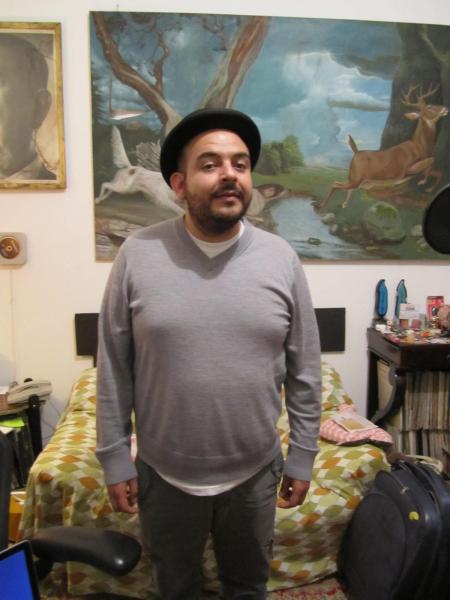So it's not surprising that La Roma, Mexico City's hipster-arty-bohemioneighbourhood is the place I am sent to meet Camilo Lara, frontman of Latin electro-pop band, Mexican Institute of Sound. However, as one of Mexico’s international musical successes, I was expecting to encounter someone a little more...famous-like?
Actually I was relieved when Camilo opened the door and warmly received me with a massive grin, laughing at the fact that I was more or less soaked through as a consequence of the unpredictable Mexico City weather. At this he shooed me into the refuge of his humble abode and out of the rain.
And the meeting continued in this relaxed and open manner. From his eccentric attire to the bric-a-brac decor Camilo makes no attempt to flaunt his success, at the same time sprinkling all he touches with charismatic charm. So when we went to photograph him in the studio he instigated a pause in order to put on one of his classic trilby hats with which he is so often seen.

Seeing him in his context, the MIS sound makes absolute sense: its like a msuical version of his apartment....a melange of random styles and melodies, perhaps considered folksy or traditional, even ordinario (common) to the Mexican arty middle classes, but rearranged and mixed to create a strangely pleasing mix of Mexican cumbia with electronic dance beats.
“Music is flavours, so one day you`ll eat curry and the other day you`ll have a tortilla and between them you might find a flavour that you didn’t know. That isn’t chutney, chocolate or the typical that you have on your map,” He ponders. Uuuur ...yeh, OK!
If you are wondering what this Cumbia music is anyway (and haven't checked out Candela's own guide to it), Camilo offered up his own interpretation: ‘Cumbia is the language from the streets. Something underground and definitely not glamorous’ And yet, its the style of music that links all of Mexican Institute’s songs and allows the group to speak freely and easily of the culture which surrounds them. More importantly, its how Camilo began experimenting with music.
‘I grew up with cumbia but I never liked it. But it must have stayed with me because its now come out. I always listened to pop music in my house, only contemporary music. So I grew up listening to a lot of the groups from the Manchester music scene like Happy Mondays, Stone Roses, the Charlatans and this era of music influenced me a lot. The clash of electronic and rock and on the other side there was hip hop. So about seven years ago here in Mexico City I started to make mixes with my musician friends. And after this I said OK I’m going to start doing my own. So I sent a demo to a label in Spain and they said ‘oh its horrible, do it again but better’. But my computer wasn’t apt with memory or programmes to make good music so I thought what I am going to do? I waited two weeks and then sent the same disk but in a different order and they said ‘Oh it’s really good’ and that’s how I joined the label.’
Other than his 90s Brit pop influences, I was curious to know how the Mexico City megatropolis, in which he grew up, has influenced his music. ‘I’ve kept my mind open but I always try to keep one foot in Mexico. So when I make music I keep making it in the same way as my first CD when I had less exposure because, I think, singing about you're own three blocks is to talk about Tokyo, London, New York. The local is also universal... colours and flavours may change but the problems are the same, even if you are talking cultural things and not directly universal stuff like love or death. I like to make it about things that I know. So there are lots of references about the city. So I talk about my environment. This is my eco system.’
Which is why Mexican Institute of Sound is heavy with references to Mexican culture and life - from the song ‘Juan Rulfo’ (refernce to the famous Mexican novel) to the video for ‘Yo Digo Baila, Tú Dices Dance’ where you find a Mexican couple clothed and dancing traditionally to a not-so- traditional backing of electronic music. ‘I wanted to make a song for the clubs so quite electronic but with an element of cumbia. So I took the cumbia beat, broke it up and mixed it. In the video the idea was to put the couple dancing into a context out of the norm.’

There is something a little crazy about Camilo, endearingly fragile and unstable. Culturally bi-polar maybe? Listening to different songs, feels like listening to different parts of him....‘Cyber Mambo’, ‘Cumbia’ or ‘Cha Cha Cha’ - if you want his Latin feel - ‘El Microfono’ or ‘Yo Digo Baila, Tú Dices Dance’ - for the electronic wizard.
‘When i play with a Cumbia band they say it sounds like rock and when I play with a rock band they say i sound like a cumbia so i never stay in one place.’ Whatever the diagnosis, it keeps you guessing and makes him interesting.
As the group embarks on its latest international tour there is one particular city where they want to set the record straight. ‘We played in London 3 years ago and it was a disaster. We hadn’t played that particular show before so we weren’t prepared and it was really one of the worst shows in my life. So I said I have to go back to London to fix it and erase this horrible image that we have there.’
Although it’s easy to only link Camilo’s music to the crash, bang, wallop of the Mexican megatropolis, MIS is sure to find its relevence in London, whose streets have their own calamitous and disorganised designs, not to mention the capitals’ increasing Latino population adding its flavour. ‘England is changing. Now people listen to music of other languages. Before I couldn’t play there. But now I can.’
And so London awaits a Mexican Institute of Sound with something to prove. Watch this space.
Mexican Institute of Sound will be playing at KOKO on April the 17th



















